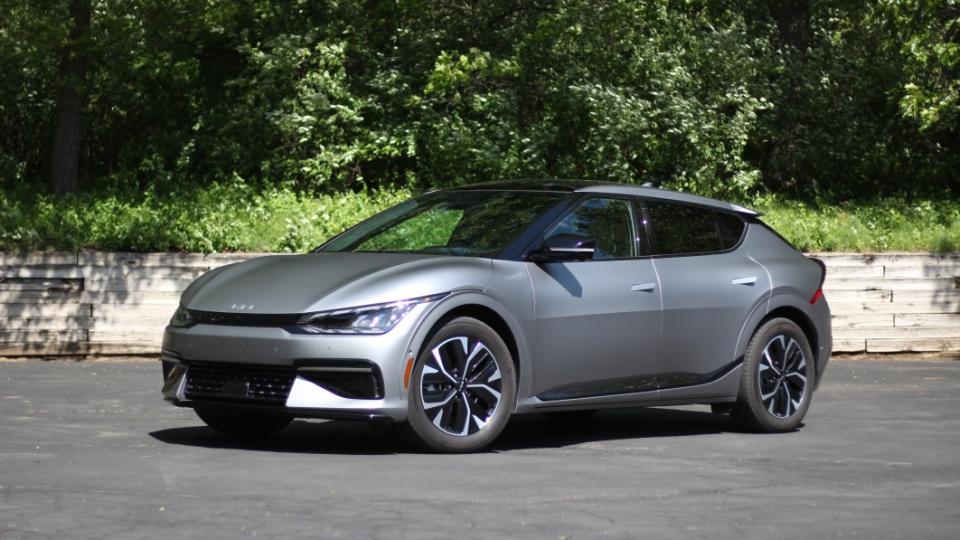2024 Kia EV6 Review: Still cool, and still one of the best EVs

Pros: Great range and rapid charging; excellent tech; top safety scores; compelling design; intense GT performance
Cons: No federal tax credit; GT has limited range and no power seats
The 2024 Kia EV6 is three years old now, and yet it’s still one of the most advanced and tech-forward electric vehicles on the market. That’s a testament to how great the design and everything hiding underneath its flashy skin was when it was brand new for the 2022 model year. There hasn’t been a version to come out that we haven’t liked either, from the middling rear-drive Wind to the neck-snapping GT, the EV6 has a little bit of goodness for any sort of would-be EV owner.
Ample range, mega-quick charging, abundantly powerful electric motors and a plethora of trims and configurations make the 2024 EV6 one of the most well-rounded EV offerings on the road. Add to all of this a fancy-looking interior with a surprising amount of utility, and you’re left with a crossover (or SUV? or wagon?) that does just about everything well. Its rear seat has a massive amount of space; same goes for the trunk, and the packaging is just as impressive, leaving you with flat floors and tons of places to store items. And despite the shape looking like it might inhibit cargo space, we actually found it to be more useful than some of its top competitors.
Ultimately, the EV6 comes out looking like one of the best EVs money can buy. We’d go so far as saying that it’s one of the best cars period that you could buy if an SUV or crossover is in your crosshairs. The lack of a federal tax credit on offer is a tough financial disincentive, but that doesn’t take away from the fact that the EV6 is a lovely car to drive and own.
Interior & Technology | Passenger & Cargo Space | Performance & Fuel Economy
What it's like to drive | Pricing & Trim Levels | Crash Ratings & Safety Features
What's new for 2024?
Kia is making it cheaper to get its biggest battery pack on offer and more powerful electric motor(s) in the EV6 this year by introducing the Light Long Range RWD and the Light e-AWD models. This pairs the big 77.4 kWh pack and stronger motors – 225 horsepower with RWD or 320 horsepower with AWD – with the lowest trim level, something that was expressly forbidden before. The cheapest model is still the Light RWD model, and it still uses the smaller 58.0 kWh battery pack and 167-horsepower motor.
The high-performance EV6 GT also gets a small range boost for 2024, increasing by 12 miles up to 218 miles on a full charge. The only other change is the addition of charge port lighting and a new charge door marking for easier access.
What are the EV6 interior and in-car technology like?
In short, it’s super cool. From the piping of colorful lighting and swoop of metal trim on the center console, to the vibrant dual displays, there’s nothing else that looks quite like this (OK, so the Niro copies it a bit). But if you want your futuristic car to look futuristic, this delivers. It should be noted there are considerable appearance and materials differences in the Wind and GT-Line trim levels, with the latter resulting in a sportier and richer environment. Is the difference worth about $4,000? Probably not, but that’s one for you to decide. The GT builds off the GT-Line with unique neon yellow accents and grippier seats, but the latter are manually adjustable, which is a misstep for a car that commands a luxury car price tag.
Despite the futuristic look, every variation of the EV6 cabin is still perfectly usable by people accustomed to the way cars operate now. There’s still a separate instrument panel, there are still traditional buttons and knobs, and even the touch-capacitive controls are better executed than those found elsewhere (cough, Volkswagen). Now, there is one wrinkle to that last bit, as the row of touch-operated buttons under the touchscreen serves double duty as climate controls and infotainment shortcuts – a swap button must be pressed to go between climate and infotainment (although the defrost and recirc buttons always remain in place). After thousands of miles spent driving our long-term EV6 (plus the similarly equipped Kia Niro and Sportage), some of our editors remain annoyed by them while others aren't bothered by them at all. The main difference in opinion comes down to how often you adjust the climate controls. All at least agree that they provide a clean look, and we're definitely seeing A LOT worse these days.


The standard 12.3-inch widescreen-oriented touchscreen is basically the same unit you’ll find in other Kias, which is great news since it’s one of the better infotainment systems out there. The menus make sense, simple tasks like changing a radio station are easy, responses are quick and it looks good. We also like the 60/40-split screen functionality that lets you look at audio and navigation, for instance, at the same time. We love the placement of the wireless phone charger right by your elbow in the center console, but wireless Apple CarPlay and Android Auto are not available, meaning you have to forego using them or plug your phone into one of the USB ports below the dash.
Another thing that needs work is the instrument panel design. Although there are three different motifs offered, they’re laid out the same with too-small speed and range readouts placed in locations where they’re frequently blocked by the wheel hub. There's too much viewable real estate devoted to nothing. The GT-Line and GT do feature an augmented reality head-up display that projects enhanced info out over the road, and gives you cues for where to turn when using navigation, which is helpful for keeping your eyes on the road.


How big is the EV6?
Huge! But also small! The EV6’s electric powertrain architecture allows it to have an extreme cab-forward design and relatively gigantic wheelbase (the same as the three-row Telluride), which means it provides immense backseat legroom for a vehicle that’s in between Kia’s Sportage and Sorento in length. We could put a rear-facing child seat in the back and have someone 6-foot-3 up front barely touching the firewall with their toes – usually their knees are jammed up against the dash. The Hyundai Ioniq 5 is similar to this, but even the Mustang Mach-E doesn’t go quite this far in terms of providing a family-friendly interior.
Up front, an open floor plan is bisected by a handy bin perfect for a sizeable purse or small backpack. Front headroom can be tight, though, at least with the GT-Line’s standard sunroof. Part of that has to do with the fact that the EV6 has a much lower roof than the SUV norm – it has barely more ground clearance than the typical car, too.
Cargo space turns out to be better than its official measurement of 24.4 cubic-feet behind its back seat. We could fit more luggage in the back than in the Hyundai Ioniq 5 and Mustang Mach-E despite both reporting more space on paper. All of the above EVs offer less than what you’d expect in a compact or midsize crossover SUV, however. In particular, the EV6’s racy roofline limits the height of any bulky objects you might fit back there.


What are the EV6 range and performance specs?
Like most other EVs, the EV6’s range and performance specs depend on battery size and whether it has a motor on only one axle or both.
The EV6 Light trim level has a 58-kilowatt-hour battery pack with a 180-kW maximum charging speed. It has rear-wheel drive courtesy of a single electric motor that produces 167 horsepower and 258 pound-feet of torque. That’s a modest output, and acceleration of 8.0 seconds from 0-60 is roughly what you’d expect from a compact SUV like a Toyota RAV4. Its EPA-estimated range is 232 miles.
Every other version of the EV6 comes with a 77.4 kWh battery pack that provides different ranges depending on drivetrain and motor type. The maximum charging output is 240-kW, which is incredibly rapid, especially at this price range. This allows it to theoretically recharge from 10% to 80% in 18 minutes should you be on a charger capable of reaching the EV6's maximum charge speeds.
Just like gas-powered crossover SUVs, the EV6 comes standard with two-wheel drive (specifically, rear-wheel drive) and offers all-wheel drive as an option. Unlike gas-powered SUVs, however, the EV6’s all-wheel drive comes from adding a second motor to power the front axle, which considerably ups performance in addition to providing added all-weather traction. It therefore doubles the usual $1,500 to $2,000 price tag of AWD.
The Light, Wind and GT-Line trim levels come standard with a single motor powering the rear wheels that produces 225 horsepower and 320 pound-feet of torque. This might not be an eye-popping output, but it’s also equivalent to the base turbocharged engines of similarly priced luxury compact SUVs. Its 0-60-mph time of 7.2 seconds isn’t quite as quick as those (the EV6 is very heavy), but it’s close. EPA-estimated range with one motor is 310 miles.
The all-wheel-drive Light, Wind and GT-Line’s added front motor results in a total output of 320 hp and 446 lb-ft of torque, and a 0-60 drop to 5.1 seconds. There’s no such thing as a free lunch, though, as range drops to 282 miles with the standard 19-inch wheel/tire combo. Step up to the GT-Line AWD model, and it comes standard with 20-inch wheels, dropping the range further to 252 miles.
The EV6 GT (new in 2023) gets more powerful front and rear motors, which ups output to 576 hp and 545 lb-ft. The 0-60 time drops to 3.4 seconds. The range plummets to a meager 218 miles, which is actually up by 12 miles versus 2023. Longer trips still won’t be very fun.


What's the EV6 like to drive?
The EV6 has many traits that fit the electric vehicle norm: immediate torque, a low center of gravity, one-pedal driving capability and an eerie quiet augmented by artificial, futuristic noises (that can be turned off). However, the Wind and GT-Line won’t try to snap your head from your neck when you plant your foot – even with the far more powerful all-wheel-drive versions. The car more judiciously doles out power to prevent wheel spin and improve drivability, which may be a downer for those moments when you want to show off what your new car can do, but it's ultimately better for efficiency and a smoother drive.

 Yahoo Autos
Yahoo Autos 

